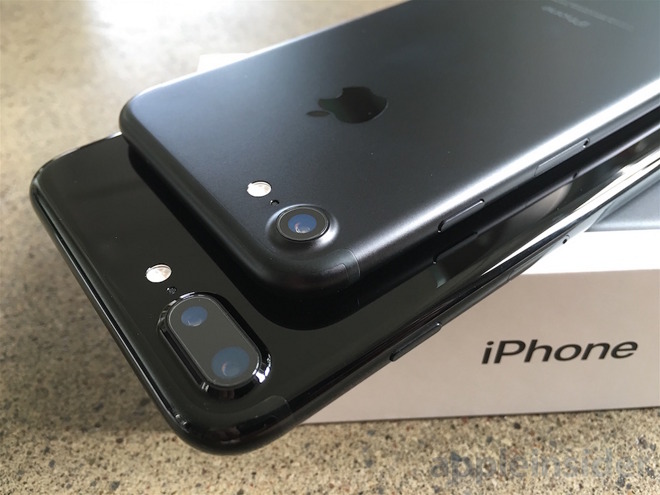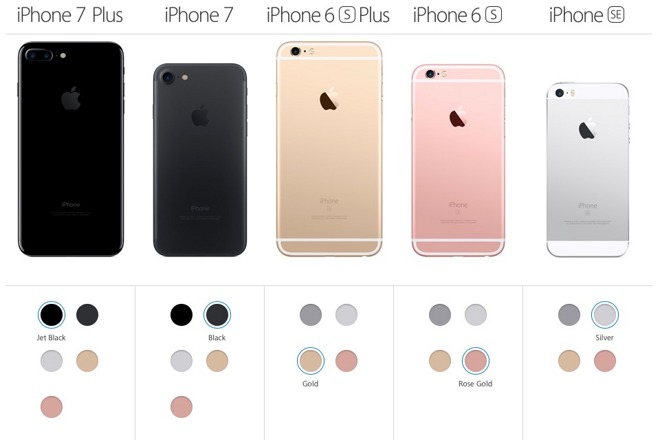Apple's latest iPhone 7 and 7 Plus are faster, sport significantly better cameras, expand system-wide haptics in iOS 10 with a new solid state Home button and Taptic Engine, introduce Wide Color and other major Retina HD technology improvements without changing their display resolutions, add new water resistance and include updates to system components ranging from RAM to storage to wireless capabilities.

iPhone 7 & 7 Plus
iPhone 7 models deliver six major categories of enhancements over Apple's iPhone 6/6s (the world's top selling smartphones): a newly harmonized Home button and 3D Touch haptic user interface paired with an enhanced Taptic Engine actuator; Wide Color Retina HD Display; a significantly improved A10 Fusion Application Processor providing enhanced speed and efficiency, paired with 2 or 3GB of RAM and larger batteries for an extra hour or two of use; new rear and FaceTime cameras and lenses with Optical Image Stabilization for more detailed low light photos and smoother video; louder new stereo speakers paired with Lightning and wireless audio and enhanced wireless connectivity that supports faster, feature-enhanced LTE Advanced mobile and MIMO WiFi; and new iP67 dust and liquid intrusion resistance.
The new iPhone 7 and iPhone 7 Plus models continue to sell alongside last year's 6s/6s Plus, which are now $100 less (starting at $550), as well as the A9-powered, 4 inch iPhone SE, which starts at $399, Apple's least expensive iPhone ever, despite its modern processor and camera technology refresh earlier this year.
In addition to their new features, iPhone 7 and 7 Plus also stand apart as the only models offering 256GB capacities (iPhone 6s models are available in 32 and 128GB versions, while iPhone SE is sold in 16GB and 64GB versions), and are Apple's only handsets currently offered in the new Black or Jet Black finishes.

What's new #1: 3D Touch, Taptic Engine, iOS 10 haptics & new Home button
Since giving its eighth generation iPhone 6 models larger and higher resolution Retina HD Displays two years ago, Apple has focused on enhancing its display quality and the usability of multitouch rather than simply bumping up pixel count and screen size, as its competitors have been doing at regular intervals (while tacking on forgettable, dead end gimmicks as 3D stereoscopic displays and banana-curved screens).
Last year, Apple's 3D Touch introduced navigation shortcuts (with app Quick Actions) and an added dimension to multitouch gestures (including Peek and Pop, iOS' 3D Touch equivalent to the keyboard-invoked QuickLook and document launching on the Mac).
Given that most iPhone 7 buyers are upgrading from iPhone 6 or older models, or are cashing in their Note 7 recall check or otherwise switching from Android, 3D Touch remains a key new feature of interest on this year's new iPhone models.
3D Touch
Resembling Force Touch on Apple Watch, iPhone 3D Touch similarly employs a "Taptic Engine" to deliver haptic feedback--literally touch sensations--delivered by a precision vibration actuator (a linear induction motor that drives a payload back and forth using electromagnets, with the accuracy of a high fidelity speaker coil).
Over the past decade, Apple has increasingly expanded its use of vibration, starting out just as a crude way to deliver a quieter alternative to a ringing telephone. As a pioneer in accessibility, Apple has applied increasingly sophisticated vibration feedback hardware and software to assist users who can't hear audio feedback, or who are guided by touch rather than sight.
Last year, Apple brought its haptic accessibility technology to mainstream users by designing its new 3D Touch to literally strike a nerve in pairing it with sophisticated and emotive Taptic Engine feedback.
However, it seemed Apple was hard pressed to evoke much excitement for the new interface concept, perhaps largely due to the fact that it was so conservatively rolled out. Apart from enabling Peek and Pop for attachments and some sporadic apps supporting Quick Actions, 3D Touch didn't seem to do a whole lot.
More often than not, experimenting with 3D Touch seemed to lead to the embarrassment of "what are you trying to do, silly human?" rather than the sort of delightful, rewarding feedback afforded by the direct manipulation interface introduced by the Macintosh, or the novel magic of multitouch on the first iPhone. Apple's 3D Touch wasn't just a feature thrown out to get some attention--it was the first step in a long term strategy.
However, unlike the gimmicky, flameout failures of Samsung's hand waving navigation or Google's Android face unlock or Amazon's face tilting parallax on the original Fire Phone (or the shockingly bad 3D Burns interface of the Galaxy Note 7), Apple's 3D Touch wasn't just a feature thrown out to get some attention--it was the first step in a long term strategy.
The new iOS 10 greatly expands the applications of 3D Touch as part of a continuum involving variable multitouch input and haptic feedback. There was once a time when adding sound effect feedback to the graphical UI of desktop computers was a novel idea. Similarly, haptic vibrations provide a layer of subtle skin feedback that can make touching a hard flat screen as familiar, emotive and intuitive as interacting with an organic being or manipulating a mechanical device.
The new iPhone 7 models get a bigger Taptic Engine capable of providing both more precise and more intense haptic feedback. This is not only used to reinforce 3D Touch gestures. In iOS 10, the system expands the use of haptics so much that audio settings are now labeled as "Sounds and Haptics."
Now activated by default in iOS 10, System Haptics provides subtle tap feedback for "system controls and interactions," including when you turn a virtual switch on or off.
Additionally, iOS 10 allows you to assign various system events (an incoming call, new email, AirDrop, reminder alerts) not just an audio alert (dings, boops and bleeps) or ringtone (short sequences of notes or other sound effects), but a custom vibration--ranging from a basic buzz to the more incessant "Rapid," an SOS signal or a half dozen other preprogrammed haptic sequences.
You can also make up your own vibration--basically a silent haptic ringtone--by tapping out a sequence. You can also assign a custom haptic vibration to a contact, so that when your lover calls, you are alerted with your own person tap sequence evoking Whitney Houston's I wanna dance with somebody (who loves me).
iOS 10 Haptics settings
